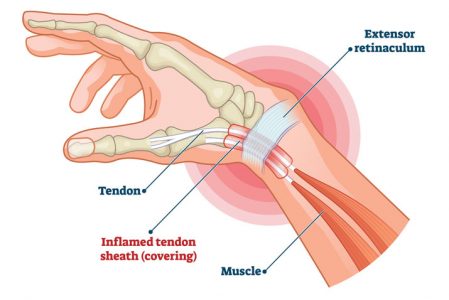Tenosynovitis

Inflamation of the protective sheath that surrounds your tendons
De Quervain’s Tenosynovitis is a painful condition that affects the tendons at the base of your thumb. These tendons pass through a tunnel as they cross the wrist joint to reach the thumb. Swelling of the tendons and/or thickening of the tunnel narrows this passageway and results in pain, swelling and a grating sensation with certain thumb and wrist movements.

FAQs
There are a number of non-surgical measures that can treat the condition. These include identifying and avoiding aggravating factors that trigger your symptoms, in addition to physiotherapy, anti-inflammatory medications, wearing a splint and a steroid injection. If your symptoms persist or recur despite such conservative measures, the problem can be dealt with surgically.
The surgery for De Quervain’s tenosynovitis is usually performed under general anaesthetic as a day case. It involves making an incision along the thumb side of your forearm near your wrist and dividing the sheath that the affected tendons run through. This provides more space for the tendons to move and alleviates your pain. The wound is closed with dissolvable stitches and a bulky bandage applied. The procedure takes approximately sixty minutes.
Some discomfort is to be expected after the surgery and Dr Collins will ensure you have adequate pain relief to deal with this. Your grip will be temporarily weaker and you may not be able to drive for a few days after your surgery. Dr Collins may refer you to a hand therapist to ensure you get the best possible functional outcome. This can take up to six weeks.
Your return to work will be determined by the type of job that you do. Patients in a supervisory role can usually return to work within a week. If your work is more physically demanding, you may require up to 4 weeks of leave.

